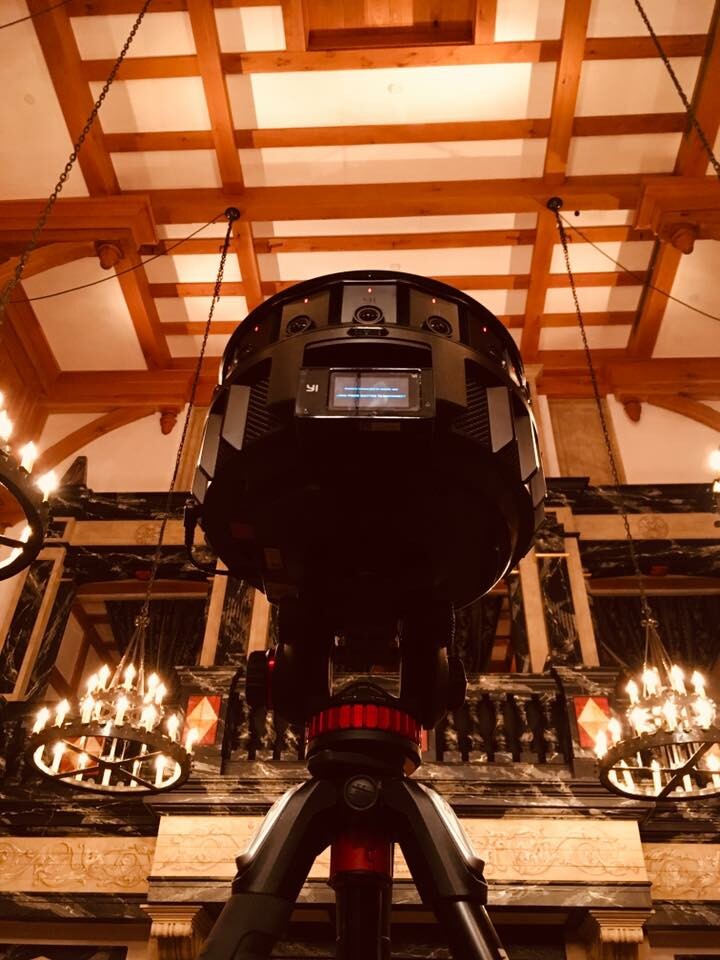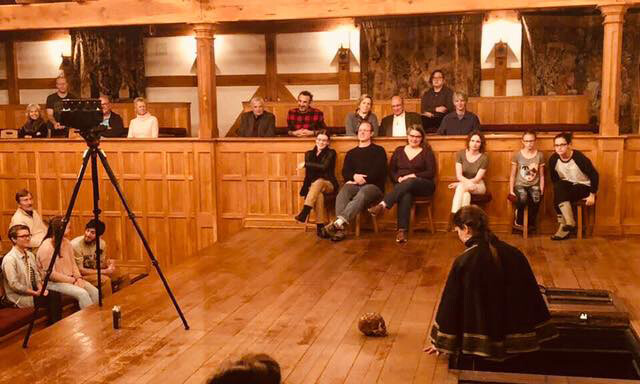Around the same time that Shakespeare-VR was being developed, TheatAR—a group made up of CMU graduate students—created Project Neverland, a staging of the opening scene of Peter Pan that uses AR technology as a way to enhance the production.
TheatAR’s project is full of thrilling promise for AR-enhanced theatre that expands what can be shown on a stage. The project’s creative director, Dan Wolpow, says that when he first heard about AR technology, he wondered what it would be like to combine real-life actors and animated characters on stage. The team noted that historically, in Peter Pan, “Tinker Bell is portrayed by a small pinpoint spotlight that shakes around as she ‘speaks,’ and flutters along the stage on a two-dimensional axis.” So, they decided to make Tinker Bell an actor herself using AR.
Creating a VR or AR experience requires a 360-degree camera to record and project a 2D object in a way that feels 3D. The TheatAR team also needed animators, coders, and character designers to help bring their virtual performer to life. The project even presented the real performers with the unique opportunity to learn how to act with a scene partner they couldn’t see.
Every audience member was also viewing the show wearing AR glasses, which allowed them to see Tinker Bell as well. Tinker Bell, though not a live performer, flew around the space in three dimensions, spoke with articulated facial movements, and interacted with the performers.
In the final iteration of this transmedia project, audience members sat in traditional theatre seats and watched performers act in real time. However, every audience member was also viewing the show wearing AR glasses, which allowed them to see Tinker Bell as well. Tinker Bell, though not a live performer, flew around the space in three dimensions, spoke with articulated facial movements, and interacted with the performers. Audiences said that when the performer made eye contact with the animated Tinker Bell, the feeling was “magical.”
The project was a learning experience for all involved, given that working with the practical realities of AR technology require new and inventive ways of lighting and designing a set. Not only did the real-life elements have to interact with and react to Tinker Bell as if she were real, they also had to integrate with the AR hardware, which required space for the cameras, enough headsets for all audience members, and a smaller scene space to limit where Tinker Bell could go.
While Shakespeare-VR created a deeper learning experience for students by transporting them to an explorable Shakespeare performance, Project Neverland enhanced a production experience by fully realizing a character that audiences have never gotten to see on stage in such a real way. These projects are only two examples of the new ways in which theatre and VR/AR technology can take advantage of the assets they each have to offer. The technology is still in its very early stages of development, which means the possibilities are also just beginning. The passion and promise in these two projects alone, though, is enough to demonstrate that the intersection of VR/AR and theatre is one worth exploring, and that the products of these collaborations are truly magical.










Comments
The article is just the start of the conversation—we want to know what you think about this subject, too! HowlRound is a space for knowledge-sharing, and we welcome spirited, thoughtful, and on-topic dialogue. Find our full comments policy here
Exciting projects! How would a teacher get access to ShakespeareVR if she or he wished to use it in teaching?
Wendy, thanks for your question! The Shakespeare-VR product was a shorter demo of what the team hopes will become a much larger project. Hopefully we will see a full-scale VR experience from them soon, but for now, if you are looking to playtest the demo with students, contacting Professor Stephen Wittek would be the best course of action.
This is really engaging! I love the idea that the integration of VR/AR technology with theatre has the potential to make education and theatre more accessible. It's fascinating to see how new technology can revive old theatre. I can't wait to hear about this more!
Thanks Sydney! There's plenty of other great articles on HowlRound about VR and AR uses in theatre to explore if you're interested, and I agree! I think that technology is going to be a big part of theatre as each continues to evolve.